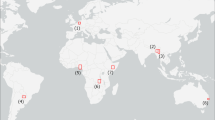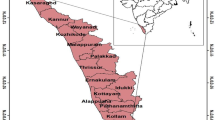Abstract
Nowadays, precipitation estimations based on satellite products (PESPs) have become an alternative source of sparse rainfall gauge data for various hydrologic applications, especially in scarce data regions like Africa which suffer from a lack of surface monitoring resources. Hence, their accuracy and performances must be evaluated by climate variance, complex topography, and geographical position due to their variation from one region to another. The Blue Nile is considered the crucial tributary of the Nile River which provides the utmost share of the river flow. So, this study aims to evaluate high-resolution PESPs [Tropical Rainfall Measuring Mission product 3B42V7 (TRMM 3B42V7) and Climate Hazards Group InfraRed Precipitation with Station data (CHIRPS)] over the Blue Nile basin (BNB) using categorical metrics [probability of detection (POD), and false alarm ratio (FAR)] and continuous statistical indicators [root mean square error (RMSE), mean absolute error (MAE), relative bias (RE), and correlation coefficient (R)] to assess its capability of rainfall amount detection and event occurrence. Hydrological river basin environmental assessment model (Hydro-BEAM) distributed model is also employed to investigate their capabilities to predict streamflow over the BNB. The hydrological daily and monthly simulations were calibrated and validated at Khartoum and Eldeim station for the period 1998–2007. Further, a hydrological monthly simulation was performed at various stations in the Eastern Nile basin (ENB) within the period 2001–2007 using Hydro-BEAM to appraise the ability of both precipitation products to predict streamflow. Moreover, a trial is made to adopt Hydro-BEAM to consider into the runoff simulation the influence of exiting dams during the simulation periods along the ENB to avoid the uncertainness and inaccuracies in simulation results.







Similar content being viewed by others
References
Abd-El Moneim H, Soliman MR, Moghazy HM (2017) Numerical simulation of Blue Nile Basin using distributed hydrological model. In: 11th International conference on the role of engineering towards a better environment (RETBE’ 17)
Abdel-Fattah M, Kantoush S, Sumi T (2015) Integrated management of flash flood in wadi system of Egypt: disaster prevention and water harvesting. Annu Disas Prev Res Inst Kyoto Univ 58:485–496
Abdel-fattah M (2017) A hydrological and geomorphometric approach to understanding the generation of wadi flash floods. Water 9:553. https://doi.org/10.3390/w9070553
Abera W, Brocca L, Rigon R (2016) Comparative evaluation of different satellite rainfall estimation products and bias correction in the Upper Blue Nile (UBN) basin. Atmos Res 178–179:471–483. https://doi.org/10.1016/j.atmosres.2016.04.017
Ali AF, Xiao C, Anjum MN et al (2017) Evaluation and comparison of TRMM multi-satellite precipitation products with reference to rain gauge observations in Hunza River basin, Karakoram Range, northern Pakistan. Sustainability 9:1954. https://doi.org/10.3390/su9111954
Alsdorf DE, Rodriguez E, Lettenmaier DP (2007) Measuring surface water from space. Rev Geophys 45:1–24
Awulachew SB, McCartney M, Steenhuis TS, Ahmed AA (2008) A review of hydrology, sediment and water resource use in the Blue Nile Basin (IWMI Working Paper 131)
Ayehu GT, Tadesse T, Gessesse B, Dinku T (2018) Validation of new satellite rainfall products over the Upper Blue Nile Basin, Ethiopia. Atmos Meas Tech 11:1921–1936. https://doi.org/10.5194/amt-11-1921-2018
Bitew MM, Gebremichael M (2011) Evaluation of satellite rainfall products through hydrologic simulation in a fully distributed hydrologic model. Water Resour Res 47:1–11. https://doi.org/10.1029/2010WR009917
Bitew MM, Gebremichael M, Ghebremichael LT, Bayissa YA (2012) Evaluation of high-resolution satellite rainfall products through Streamflow simulation in a hydrological modeling of a small mountainous watershed in Ethiopia. J Hydrometeorol 13:338–350. https://doi.org/10.1175/2011JHM1292.1
Bodian A, Dezetter A, Deme A, Diop L (2016) Hydrological evaluation of TRMM rainfall over the Upper Senegal River Basin. Hydrology 3:15. https://doi.org/10.3390/hydrology3020015
Dembélé M, Zwart SJ (2016) Evaluation and comparison of satellite-based rainfall products in Burkina Faso, West Africa. Int J Remote Sens 37:3995–4014. https://doi.org/10.1080/01431161.2016.1207258
Dinku T, Ceccato P, Grover-Kopec E et al (2007) Validation of satellite rainfall products over East Africa’s complex topography. Int J Remote Sens 28:1503–1526. https://doi.org/10.1080/01431160600954688
Eldardiry H, Hossain F (2019) Understanding reservoir operating rules in the transboundary Nile River Basin using macroscale hydrologic modeling with satellite measurements. J Hydrometeorol 20:2253–2269. https://doi.org/10.1175/jhm-d-19-0058.1
Fenta AA, Yasuda H, Shimizu K et al (2018) Evaluation of satellite rainfall estimates over the Lake Tana basin at the source region of the Blue Nile River. Atmos Res 212:43–53. https://doi.org/10.1016/j.atmosres.2018.05.009
Funk CC, Peterson PJ, Landsfeld MF et al (2014) A quasi-global precipitation time series for drought monitoring. US Geol Surv Data Ser 832:4. https://doi.org/10.3133/ds832
Funk C, Verdin A, Michaelsen J et al (2015) A global satellite-assisted precipitation climatology. Earth Syst Sci 7:275–287
Gebrehiwot SG, Ilstedt U, Gärdenas AI, Bishop K (2011) Hydrological characterization of watersheds in the Blue Nile Basin, Ethiopia. Hydrol Earth Syst Sci 15:11–20. https://doi.org/10.5194/hess-15-11-2011
Gebremicael TG, Mohamed YA, Zaag P Van Der, Amdom G (2017) Hydrological characterization of watersheds in the Blue Nile Basin, Ethiopia. Hydrol Earth Syst Sci15:11-20. https://doi.org/10.5194/hess-15-11-2011
Gebremicael TG, Mohamed YA, Der P Van et al (2019) Evaluation of multiple satellite rainfall products over the rugged topography of the Tekeze-Atbara basin in Ethiopia. Int J Remote Sens 1–20. https://doi.org/10.1080/01431161.2018.1562585
Gella GW (2019) Statistical evaluation of high resolution satellite precipitation products in arid and semi-arid parts of Ethiopia: a note for hydro-meteorological applications. Water Environ 33:86–97. https://doi.org/10.1111/wej.12380
Guo R, Liu Y (2016) Evaluation of satellite precipitation products with rain gauge data at different scales: implications for hydrological applications. Water (Switzerland) 8:281. https://doi.org/10.3390/w8070281
Hirpa FA, Gebremichael M, Hopson T (2010) Evaluation of high-resolution satellite precipitation products over very complex terrain in Ethiopia. J Appl Meteorol Climatol 49:1044–1051. https://doi.org/10.1175/2009JAMC2298.1
Huang Y, Chen S, Cao Q et al (2014) Evaluation of version-7 TRMM multi-satellite precipitation analysis product during the Beijing extreme heavy rainfall event of 21 July 2012. Water (Switzerland) 6:32–44. https://doi.org/10.3390/w6010032
Huffman GJ, Bolvin DT, Nelkin EJ et al (2007) The TRMM multisatellite precipitation analysis (TMPA): quasi-global, multiyear, combined-sensor precipitation estimates at fine scales. J Hydrometeorol 8:38–55. https://doi.org/10.1175/JHM560.1
Jiang S, Liu S, Ren L et al (2017) Hydrologic evaluation of six high resolution satellite precipitation products in capturing extreme precipitation and streamflow over a medium-sized basin in China. Water (Switzerland) 10:1–17. https://doi.org/10.3390/w10010025
Joyce RJ, Janowiak JE, Arkin PA, Xie P (2004) CMORPH: a method that produces global precipitation estimates from passive microwave and infrared data at high spatial and temporal resolution. J Hydrometeorol 5:487–503. https://doi.org/10.1175/1525-7541(2004)005%3c0487:CAMTPG%3e2.0.CO;2
Karamouz M, Nazif S, Falahi M (2013) Hydrology and hydroclimatology. Principles and applications. CRC Press, USA
Knapp K, Ansari S, Bain C et al (2011) Globally gridded satellite observations for climate studies. Bull Am Meteorol Soc 92:893–907. https://doi.org/10.1175/2011BAMS3039.1
Kojiri T, Tokai A, Kinai Y (1998) Assessment of river basin environment through simulation with water quality and quantity. Annu Disaster Prev Res Inst Kyoto Univ 41:119–134
Lu X, Tang G, Wei M et al (2018) Evaluation of multi-satellite precipitation products in Xinjiang, China Evaluation of multi-satellite precipitation products in Xinjiang, China. Int J Remote Sens 00:1–26. https://doi.org/10.1080/01431161.2018.1471246
Moriasi DN, Arnold JG, Liew MW et al (2007) Model evaluation guidelines for systematic quantification of accuracy in watershed simulations. Trans ASABE 50:885–900. https://doi.org/10.13031/2013.23153
Muala E, Mohamed YA, Duan Z, Van Der ZP (2014) Estimation of reservoir discharges from Lake Nasser and Roseires Reservoir in the Nile Basin using satellite altimetry and imagery data. Remote Sens 6:7522–7545. https://doi.org/10.3390/rs6087522
MWRI (1998a) Measured discharges of the Nile and/its tributaries every 5 years. Egypt
MWRI (1998b) Monthly and annual rainfall totals and number of rainy days at stations in and near the Nile Basin for every 5 years. Egypt
Nash JE, Sutcliffe JV (1970) Riverflow forecasting through conceptual models. Part I: a discussion of principle. J Hydrol 10:282–290
Peng B, Shi J, Ni-Meister W et al (2014) Evaluation of TRMM multisatellite precipitation analysis (tmpa) products and their potential hydrological application at an arid and semiarid basin in china. IEEE J Sel Top Appl Earth Obs Remote Sens 7:3915–3930. https://doi.org/10.1109/JSTARS.2014.2320756
Ragab O (2014) Flood forecasting in Blue Nile basin using a process-based hydrological model. Int J Environ 3:1–12. https://doi.org/10.3126/ije.v3i1.9938
Ragab O, Valeriano OCS (2014) Flood forecasting in Blue Nile Basin using a process-based distributed hydrological model and satellite distributed hydrological model and satellite derived precipitation product. In: ASEE 2014 Zone I Conference. USA
Saber M (2010) Hydrological approaches of wadi system considering flash floods in arid regions. Kyoto University, Japan
Saber M, Yilmaz K (2016) Bias correction of satellite-based rainfall estimates for modeling flash floods in semi-arid regions: application to Karpuz River, Turkey. Nat Hazards Earth Syst Sci Discuss 1–35. https://doi.org/10.5194/nhess-2016-339
Saber M, Yilmaz KK (2018) Evaluation and bias correction of satellite-based rainfall estimates for modelling flash floods over the Mediterranean region: application to Karpuz River Basin, Turkey. Water (Switzerland) 10:657. https://doi.org/10.3390/w10050657
Saber M, Hamaguchi T, Kojiri T et al (2013) A physically based distributed hydrological model of wadi system to simulate flash floods in arid regions. Arab J Geosci 58:485–496. https://doi.org/10.1007/s12517-013-1190-0
Serrat-Capdevila A, Merino M, Valdes JB, Durcik M (2016) Evaluation of the performance of three satellite precipitation products over Africa. Remote Sens 8:836. https://doi.org/10.3390/rs8100836
Sorooshian S, Hsu K, Gao X et al (2000) Evaluation of PERSIANN system satellite based estimates of tropical rainfall. Bull Am Meteorol Soc 81:2035–2046. https://doi.org/10.1175/1520-0477(2000)081%3c2035:EOPSSE%3e2.3.CO;2
Sun R, Yuan H, Liu X, Jiang X (2016) Evaluation of the latest satellite-gauge precipitation products and their hydrologic applications over the Huaihe River basin. J Hydrol 536:302–319. https://doi.org/10.1016/j.jhydrol.2016.02.054
Tan ML, Duan Z (2017) Assessment of GPM and TRMM precipitation products over Singapore. Remote Sens 9:720. https://doi.org/10.3390/rs9070720
Tan ML, Ibrahim AL, Duan Z et al (2015) Evaluation of six high-resolution satellite and ground-based precipitation products over Malaysia. Remote Sens 7:1504–1528. https://doi.org/10.3390/rs70201504
Tong K, Su F, Yang D, Hao Z (2014) Evaluation of satellite precipitation retrievals and their potential utilities in hydrologic modeling over the Tibetan Plateau. J Hydrol 519:423–437. https://doi.org/10.1016/j.jhydrol.2014.07.044
Toté C, Patricio D, Boogaard H et al (2015) Evaluation of satellite rainfall estimates for drought and flood monitoring in Mozambique. Remote Sens 7:1758–1776. https://doi.org/10.3390/rs70201758
Walters BMO (1990) Transmission losses in arid region. J Hydraul Eng 116:129–138
Wang Z (2016) Evaluating the suitability of TRMM satellite rainfall data for hydrological simulation using a distributed hydrological model in the Weihe River catchment in China. J Geogr Sci. https://doi.org/10.1007/s11442-015-1161-3
Wang Z, Zhong R, Lai C (2017) Evaluation and hydrologic validation of TMPA satellite precipitation product downstream of the Pearl River Basin, China. Hydrol Process 31:4169–4182. https://doi.org/10.1002/hyp.11350
Wang N, Liu W, Sun F et al (2020) Evaluating satellite-based and reanalysis precipitation datasets with gauge-observed data and hydrological modeling in the Xihe River Basin, China. Atmos Res 234:104746. https://doi.org/10.1016/j.atmosres.2019.104746
Washington R, Kay G, Harrison M, Conway D et al (2006) African climate change: taking the shorter route. Bull Am Meteorol Soc 87(10):1355–1366
Worqlul AW, Maathuis B, Adem AA et al (2014) Comparison of rainfall estimations by TRMM 3B42, MPEG and CFSR with ground-observed data for the Lake Tana basin in Ethiopia. Hydrol Earth Syst Sci 18:4871–4881. https://doi.org/10.5194/hess-18-4871-2014
Xue X, Hong Y, Limaye AS et al (2013) Statistical and hydrological evaluation of TRMM-based multi-satellite precipitation analysis over the Wangchu Basin of Bhutan: are the latest satellite precipitation products 3B42V7 ready for use in ungauged basins? J Hydrol 499:91–99. https://doi.org/10.1016/j.jhydrol.2013.06.042
Zhang C, Chen X, Shao H et al (2018) Evaluation and intercomparison of high-resolution satellite precipitation estimates—GPM TRMM, and CMORPH in the Tianshan Mountain Area. Remote Sens. https://doi.org/10.3390/rs10101543
Acknowledgements
The authors thank the late professor Kojiri, Prof. Sumi from DPRI for support by sharing the main program of Hydro-BEAM and Dr. Mohamed Saber for his help by sharing the adopted Hydro-BEAM. The authors also thank Prof. Sameh Kantoush and Dr. Mohamed Saber for their support and their efforts to attend the 5th International Symposium on Flash Floods in Wadi Systems.
Author information
Authors and Affiliations
Corresponding author
Ethics declarations
Conflict of interest
None.
Rights and permissions
About this article
Cite this article
Abdelmoneim, H., Soliman, M.R. & Moghazy, H.M. Evaluation of TRMM 3B42V7 and CHIRPS Satellite Precipitation Products as an Input for Hydrological Model over Eastern Nile Basin. Earth Syst Environ 4, 685–698 (2020). https://doi.org/10.1007/s41748-020-00185-3
Received:
Accepted:
Published:
Issue Date:
DOI: https://doi.org/10.1007/s41748-020-00185-3




